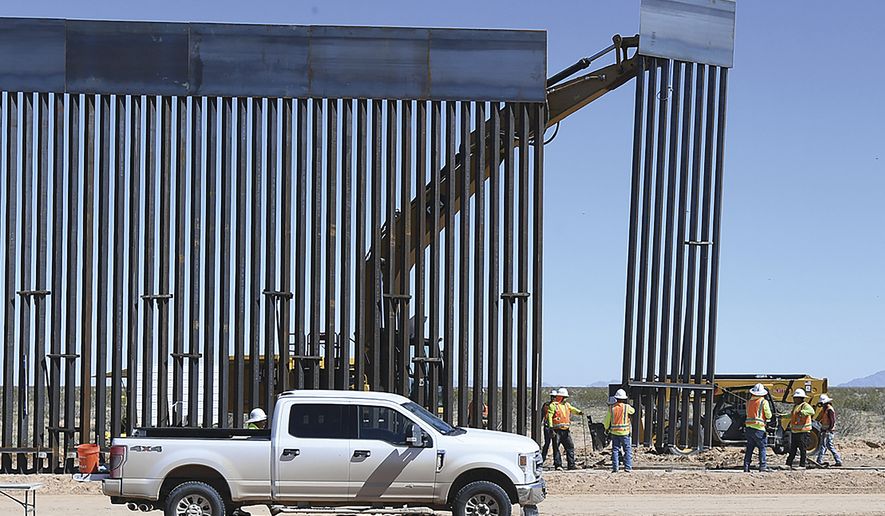President Trump’s wall is the most aggressive border construction project in U.S. history — but it just got 22 miles shorter.
The latest calculations for how much wall can be built with the $15 billion Mr. Trump has won from Congress or siphoned from other Pentagon accounts works out to 731 miles, which would be more border fence than every previous president combined has built.
But it’s also 22 miles shorter than the Department of Homeland Security and the Army Corps of Engineers were projecting at the beginning of April. Officials said a certain pot of Defense Department money can’t stretch as far as they originally thought.
John B. Mennell, assistant chief at Customs and Border Protection headquarters, said the earlier, larger assessment was made based on rough order of magnitude estimates for one $3.8 billion chunk of money in the Defense Department’s drug interdiction account, projected to cover 177 miles of wall in segments from San Diego to Del Rio, Texas.
Once specific projects were finalized, though, they had to recalculate how far the $3.8 billion would stretch.
“ROMs are estimates based on averages and not actual locations, which can vary from one mile to the next. Once planning efforts began and cost estimates were finalized, based on the final approved project list, the total mileage was updated to approximately 155 miles,” Chief Mennell said.
While much of the country has been shuttered by stay-at-home orders in response to the COVID-19 pandemic, wall planning and construction have continued uninterrupted.
Since early February, a total of 51 miles have been built — 42 of them replacing outdated designs and 9 miles in places where no fencing existed before. Only one of those new miles is up against the border. The other eight are secondary fencing set back from the primary barrier to create a corridor to nab illegal immigrants.
When Mr. Trump took office, about 354 miles of border were protected by a pedestrian fence and another 300 miles with vehicle barriers, which are easy to walk over but can deter kamikaze drive-throughs, for a total of 654 miles.
With the projects currently planned, that will rise to 945 miles. Of those, 731 will be upgraded or added through Mr. Trump’s orders.
The new wall design can reach 30 feet high, with 6-inch square steel bollards spaced 4 inches apart. That is enough to allow small wildlife, but not people, to squeeze through. Anti-climb plates are intended to deter attempts to go over the wall.
The Border Patrol is in charge of selecting wall locations, and the Army Corps of Engineers is handling the contracts.
Homeland Security last week introduced a website that shows a video of wall being built in California’s El Centro sector. The website also includes an interactive map to see where the wall improvements are planned.
Since taking office, Mr. Trump has won about $4.5 billion from Congress for wall funding, and he has siphoned about $600 million from a Treasury Department account and $10 billion from Pentagon accounts. Of that Defense Department money, $3.6 billion went into an emergency military construction account and another $6.3 billion topped off a counternarcotics fund that allows border barrier construction.
It was that last pot of money that caused the 22-mile cut.
Earlier this month, the Army Corps projected that 177 miles could be built with $3.8 billion. That worked out to about $21.5 million per mile. But after matching the money to specific projects, it now looks like it will cover only 155 miles, at $24.5 million per mile.
A spokesman for the Corps did not comment in time for publication.
Border officials have said from the beginning that they expect costs to fluctuate.
A court filing last week detailed four wall segments that ranged in price from about $20 million per mile up to $105 million for a stretch near Yuma, Arizona, that could be as short as 1 mile of new and replacement wall. That project includes $50 million for fiber-optic cables and a power distribution system, according to the court filing.
“Our border communities need resources to fight the coronavirus and protect people and front-line workers, but the Trump administration is instead subjecting us to a destructive wall without regard for the law, the landscape or costs to Americans,” said Dan Millis, the borderlands program manager for the Sierra Club’s Grand Canyon Chapter.
The Sierra Club is one of a number of plaintiffs challenging wall construction, Mr. Trump’s ability to siphon money out of Pentagon accounts, and the waivers the homeland security secretary has issued to exempt wall construction from dozens of laws such as the Endangered Species Act, the Safe Drinking Water Act and the Native American Graves Protection and Repatriation Act.
The Supreme Court has allowed wall construction to proceed while those lawsuits are being heard.
Some of the wall contracts have drawn scrutiny.
A $569 million award to build 17.7 miles of fencing in San Diego, which works out to $32.1 million per mile, went to BFBC, a company run by a man who gives frequently to Republican campaigns.
The Government Accountability Office is investigating that contract, according to the top Democrat on the Senate Armed Services Committee.
The chairman of the House Homeland Security Committee has asked the Defense Department’s inspector general to investigate.
Mr. Mennell said that contract was not part of the project that was reduced by 22 miles.
• Stephen Dinan can be reached at sdinan@washingtontimes.com.




Please read our comment policy before commenting.